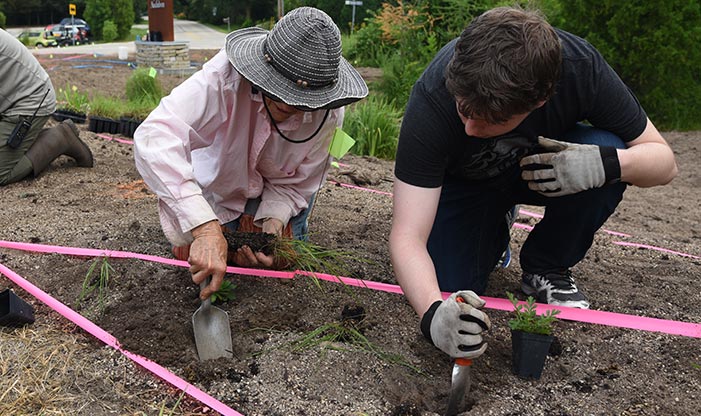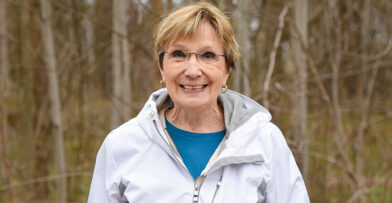The trails and habitats at Schlitz Audubon are full of natural wonder, and our varied ecosystems make the Center a great place to visit. Our Volunteer Land Stewards deserve much of the credit for maintaining and restoring these habitats. Removing invasive species and planting native ones are just a couple of ways that they improve the Center throughout the seasons.
Getting Ready to Work
These volunteers meet in the Great Hall by 9:00am on Mondays, Wednesdays, Fridays, and Saturdays. There, they can catch up while they wait to hear about the day’s work. Sarah Long, Land Manager at the Center, leads the Land Steward team. On any given day, Sarah will designate assignments, and then volunteers will split up into groups and head out to areas where conservation work is needed.
John Lunz has been volunteering at the Center for about four years. A former engineer, he said it’s like a second career for him. He volunteers for a number of nature organizations in addition to the Center, because as John put it, “There’s so much that needs to be done.”
For about three hours at a time, volunteers get fresh air, sunlight, and socialize while performing a valuable service. Based on volunteer hours, the most common type of work these volunteers perform is cutting away and treating invasive woody species like common buckthorn, hand pulling dame’s rocket and garlic mustard, maintaining the trails, planting native species, and hazardous tree reduction.
The Battle Against Invasive Species
Volunteer Land Stewards are friendly and welcoming, helping newcomers learn the role. Recently, one of the groups went out to remove buckthorn, an invasive woody-stemmed plant that can take over oak forests, savannas, prairies and fields. Buckthorn is a threat for a number of reasons. It has a much longer growing season than most native species, and creates dense shade that inhibits the growth of other plants. It also produces chemicals that are bad for surrounding vegetation.
Large swaths of buckthorn can be mowed down when it exists apart from other species of plants and trees. At the Center, however, there are some areas where buckthorn thrives that are considered to be high-quality habitat. In those areas, other important species live alongside the Buckthorn, so it can’t be mowed down all at once. This means the buckthorn needs to be removed by hand, a very labor-intensive process. It is a constant struggle to keep this invasive species at bay.
The Role of Volunteer Land Stewards
These volunteers are vital in the battle against Buckthorn and other invasive species such as garlic mustard and dame’s rocket. Sarah trains new volunteers in basic tree and plant identification. Then, they are put to work shearing and treating invasive species that exist alongside desirable species. This precision work is important because native species need space to grow. Volunteers help each other identify the plants to be sure that the invasives are correctly identified and removed.
Judy Wick, a regular at the Center, will often shear a large number of buckthorn from patches that may also be home to desirable species like dogwood. She started volunteering three years ago after she moved to Wisconsin to be near her grandchildren. Now living in a condominium, she said she enjoys being able to work in a natural setting, getting close to plants that she doesn’t have in her own yard.
Volunteers have a variety of reasons for being land stewards. Many enjoy being outside, working to conserve the land, or being part of this community. They find helping to restore the land at Schlitz Audubon rewarding.
In 2022, our Volunteer Land Stewards contributed more than 4100 hours of their valuable time to keeping the Center vibrant. Thank you to all of our Volunteer Land Stewards!
Updated on April 19, 2023.


